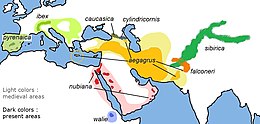| Capra Temporal range: Early Pleistocene – Present
| |
|---|---|

| |
| Capra, St. Leonhard in Passeier, Italy | |
| Scientific classification | |
| Domain: | Eukaryota |
| Kingdom: | Animalia |
| Phylum: | Chordata |
| Class: | Mammalia |
| Order: | Artiodactyla |
| Family: | Bovidae |
| Subfamily: | Caprinae |
| Tribe: | Caprini |
| Genus: | Capra Linnaeus, 1758 |
| Type species | |
| Capra hircus | |
| Species | |
|
See text. | |

| |
| Approximate range of the Capra species | |
Capra is a genus of mammals, the goats, comprising ten species, including the markhor and several species known as ibexes. The domestic goat (Capra hircus) is a domesticated species derived from the bezoar ibex (Capra aegagrus aegagrus). It is one of the oldest domesticated species of animal—according to archaeological evidence its earliest domestication occurred in Iran at 10,000 calibrated calendar years ago.[1]
Wild goats are animals of mountain habitats. They are very agile and hardy, able to climb on bare rock and survive on sparse vegetation. They can be distinguished from the genus Ovis, which includes sheep, by the presence of scent glands close to the feet, in the groin, and in front of the eyes, and the absence of other facial glands, and by the presence of a beard in some specimens, and of hairless calluses on the knees of the forelegs.[2]
- ^ Zeder, Melinda A.; Hesse, Brian (2000). "The Initial Domestication of Goats (Capra hircus) in the Zagros Mountains 10,000 Years Ago". Science. 287 (5461): 2254–7. Bibcode:2000Sci...287.2254Z. doi:10.1126/science.287.5461.2254. PMID 10731145. Archived from the original on July 7, 2022. Retrieved June 30, 2022.
- ^ Parrini, F.; et al. (2009). "Capra ibex (Artiodactyla: Bovidae)". Mammalian Species. 830: 1–12. doi:10.1644/830.1.